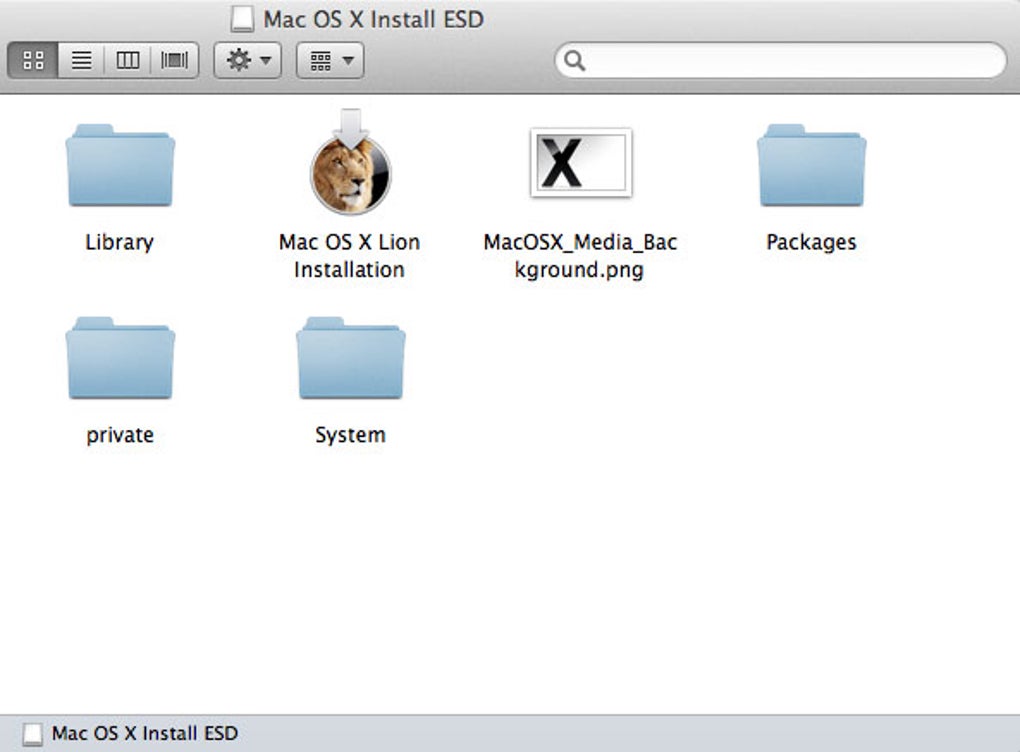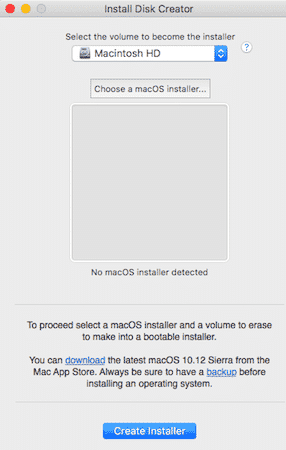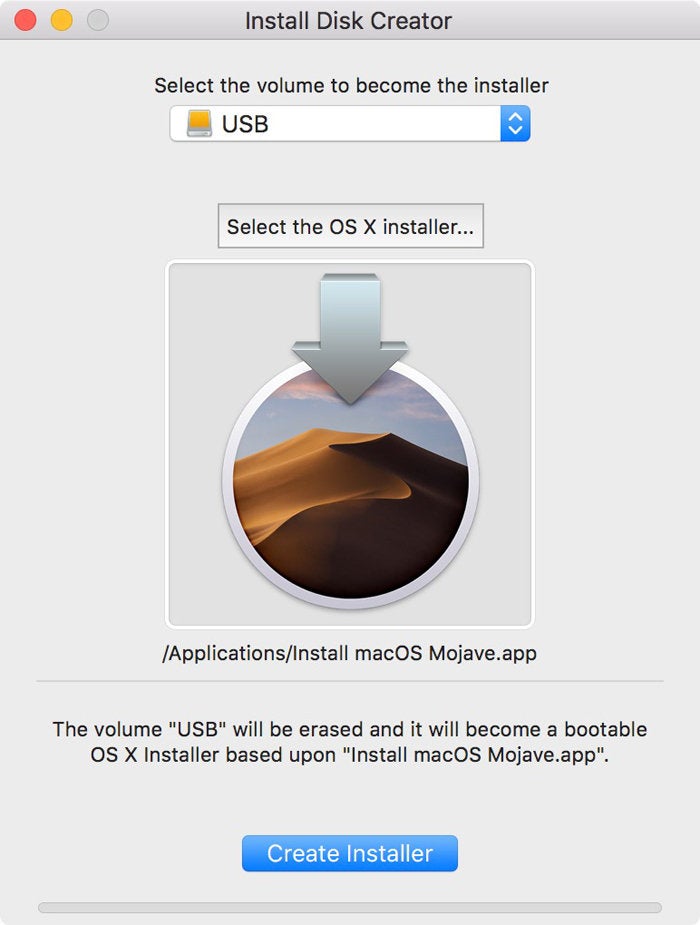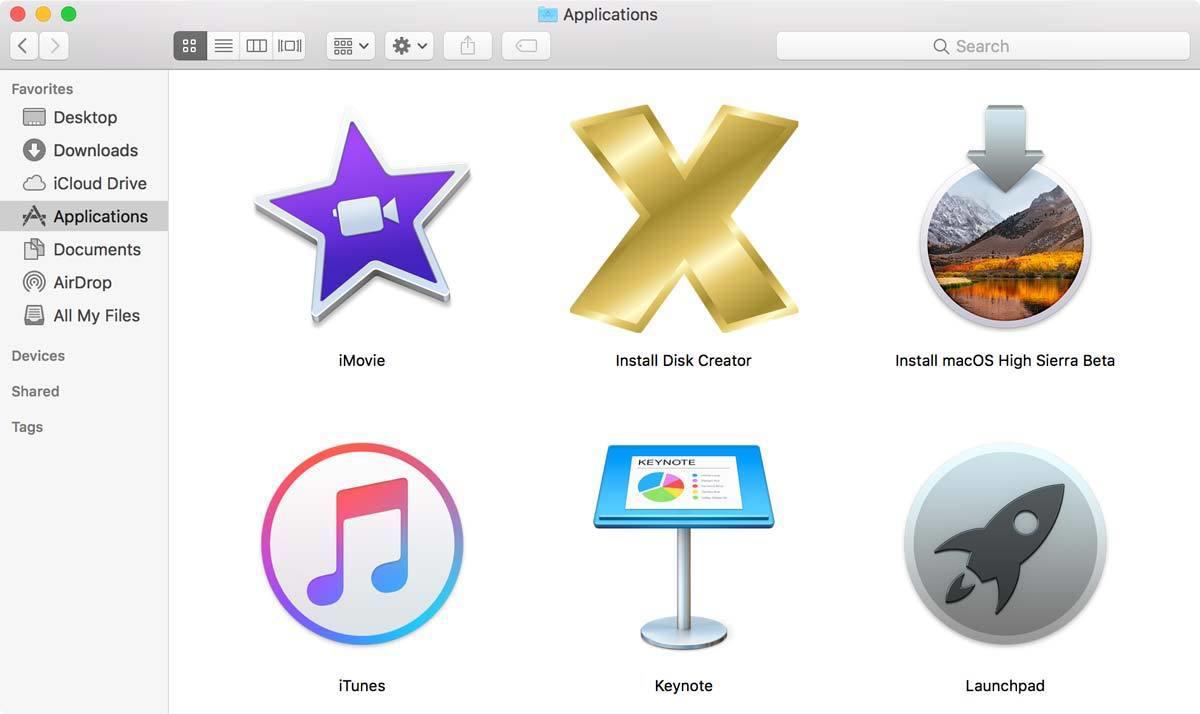- Mac Disk Creator For Windows
- Mac Disk Creator 10.6
- Mac Install Disk Creator Error Encountered
- Mac Disk Creator For Windows
- The interface of Bootable USB Drive Creator Tool is so easy to read and use that even less experienced users can have a go at using this software and successfully make an USB connected device.
- Install Disk Creator. Make a bootable OS X Installer. Use it for clean installs. Take a webcam photo on wake from sleep. Capture snoops and selfies.
What's Windows To Go
- From Wikipedia, the free encyclopedia
'Windows To Go is a feature in Windows 8.1 Enterprise, Windows 8 Enterprise, Windows 10 Enterprise, and Windows 10 Education that allows them to boot and run from certain USB mass storage devices such as USB flash drives and external hard disk drives which have been certified by Microsoft as compatible. It is a fully manageable corporate Windows environment.'
According to Wiki's explanation, the creation of Windows To Go drives provides users with an imaged version of Windows, which allows them to take Windows OS anywhere on any compatible device. It's particularly useful when Windows startup issues occurred, such as your PC couldn't start properly.
However, the Windows To Go feature is confined and only available in Windows 10 Education and Windows 8/8.1/10 Enterprise. Can Windows users out of the supported Windows editions enjoy the Windows To Go convenience and create bootable USB of their own?
Disk Drill isn’t a Snipping Tool alternative for Mac computers — it’s something even better. With Disk Drill, you can recover all common and not-so-common image file formats, so you’ll never lose any of your screenshots, pictures, videos, music, documents, or any other files since Disk Drill supports the recovery of over 200 file formats. All-in-one video creator for Mac: an editor, converter, screen recorder, and more. 800 MB available hard disk space for installation, 500 MB for ongoing operations.
It's possible, actually, by either using Diskpart command line or third-party Windows To Go creator.
The Best Windows To Go Creator for Windows 10/8.1/8/7
When it comes to creating a portable Windows USB drive that performs like Windows To Go drive, we'd like to introduce you EaseUS Todo Backup. It's Windows backup software, USB bootable software as well as disk/partition clone utility that supports to migrate OS to a new drive along with all its configuration. Besides, you can create a portable Windows USB drive under its system clone feature.
Video tutorial:
To create a Windows To Go bootable USB drive, follow this guide.
Step 1. Insert your USB flash drive into a Windows computer. Launch EaseUS Todo Backup and click System Clone.
Step 2. Choose the USB drive as the destination disk to clone system disk (Only make sure that your USB drive has to be bigger than the source disk). Click on Advanced options and then Create Portable Windows USB drive. Click Next.
Step 3.Now the system disk containing your personalized operating system and boot files will be imaged to the USB flash drive.
Summary :
Windows cannot be installed to MBR/GPT disk? Windows cannot be installed to dynamic disk? These are the most common issues that can occur during the process of Windows 10/8/7 installation. This post shows how to address such issues with detailed steps given.
Quick Navigation :
When installing Windows OS (whether it is a clean install, reinstall or dual boot), you may receive various kinds of errors saying Windows cannot be installed to this disk. In this post, we will introduce 6 types of Windows installation errors as well as top corresponding solutions.
Error 1: Windows Cannot Be Installed to This Disk. The Selected Disk Is of the GPT Partition Style.
When installing Windows on a GPT disk, you may receive Windows cannot be installed on GPT disk error:
'Windows cannot be installed to this disk. The selected disk is of the GPT partition style.'
What causes this error?
Reasons
This is mainly because the motherboard supports Legacy BIOS only rather than both Legacy and UEFI or CSM boot. Under legacy BIOS mode, you can only install Windows to an MBR disk since traditional BIOS cannot recognize GPT partition, but data read/write on GPT disk is available as long as Windows supports it.
Solutions
To fix this error, firstly you need to enter BIOS Setup to see what the boot mode it is set to. Start/restart computer and continuously press a key to enter BIOS before the Windows logo appears. Different computers may require different keys, so you had better search 'how to enter BIOSplus computer trademark or motherboard name' on the internet to find the exact key.
In BIOS, if you find no signal showing you are using a UEFI motherboard like the following picture shows, maybe you are using a traditional motherboard which supports legacy BIOS boot only. Under this situation, the only solution is to convert the GPT disk to an MBR disk.
Here are the deals:
Solution 1. Convert GPT Disk to MBR if the Motherboard Supports Legacy BIOS Only
1) Use Partition Wizard
MiniTool Partition Wizard Free Edition is a free yet outstanding partitioning tool for Windows NON-SERVER users, which helps to convert GPT disk to MBR disk without losing data when an existing Windows is available. However, you should know that Partition Wizard can only change non-system GPT disk to MBR disk without bringing any data loss. This works for all Windows XP/Vista/7/8/10 users.
Step 1: run MiniTool Partition Wizard.
Launch MiniTool Partition Wizard. Then right-click on the target disk to be converted and choose 'Convert GPT Disk to MBR Disk'.
Step 2: confirm the conversion.
You will see the GPT attribute has turned to MBR. However, this is only pending operations for us to preview. Please press 'Apply' to confirm the change. After the conversion, you will find that all data is still there.
2) Use Diskpart
It is possible to make the conversion during the installation process. Please do the following:
Step 1: call out CMD.
Once the error pops up, click 'OK' to close the error and try pressing on 'Shift + F10' to call out CMD. If the utility does not emerge, please go back to the install Windows interface, then press 'Shift + F10' again to launch CMD.
Step 2: clean the disk and convert it to MBR.
Now you need to do a clean on the disk by typing the following commands:
'diskpart -> list disk -> select disk 1 (1 signifies the number of GPT disk) -> clean -> convert MBR.'
When diskpart shows it has successfully converted the selected disk to MBR format, you can exit from this program and continue to install Windows.
3) Use Disk Management Utility
If another Windows OS is available on the same computer, then Disk Management utility is helpful. Try these operations:
Step 1: go to Disk Management.
Start the working Windows and enter the built-in Disk Management tool by right clicking the 'Computer' icon on the desktop, choosing 'Manage', and selecting 'Disk Management'.
Step 2: delete volume.
Delete all partitions or volumes on the GPT disk one by one via the right-click function 'Delete Volume'.

Step 3: convert to MBR disk.
When the entire disk becomes an unallocated space, right click the GPT disk and choose 'Convert to MBR Disk'. After these steps, the original GPT disk will be converted to an MBR disk, and then you can go on installing Windows on this disk.
Solution 2. Change Boot Mode If the Motherboard Supports Both Legacy and UEFI Boot
Currently, most motherboards support both the Legacy boot and UEFI boot, and users can choose the most appropriate one manually. If you select Legacy only, it will be impossible to install Windows on GPT disk. At this time, you can enter BIOS and set the boot mode to CSM boot or choose Both.
Once the change has been made, please press on F10 to save changes, and then you can install Windows on a GPT disk.
Error 2: Windows Cannot Be Installed to This disk. The Selected Disk Has an MBR Partition Table.
When installing Windows 7, Windows 8 or other newly released Windows OS, you may receive another error saying Windows cannot be installed on MBR disk:
'Windows cannot be installed on this disk. The selected disk has an MBR partition table. On EFI systems, Windows can only installed on GPT disks'.
Why can't Windows be installed on an MBR disk under EFI systems?
Reasons
To answer this question, you need to know something about UEFI + GPT boot. Under EFI systems, theoretically both an MBR disk and GPT disk can be used to boot operating systems, but Microsoft rules Windows can only be installed on a GPT disk. To fix this error, the best way is to convert the MBR disk to a GPT disk.
Solutions
Convert MBR Disk to GPT Disk to Fix the Error
Steps are nearly the same as those to convert GPT disk to MBR disk, and the only difference is that you need to convert disk to GPT rather than MBR. For converting without data loss, please see Convert MBR Disk to GPT Disk for more details.
That's not all…In the former part, we have said most UEFI motherboards support both Legacy boot and UEFI boot but we can change it manually. If the error is caused by setting boot mode to be UEFI only, changing the mode to Both or CSM boot may fix the error, which has been introduced in Error 1.
Error 3: Windows Cannot Be Installed on Dynamic Disk.

When installing Windows on a dynamic disk, you may receive this message:
'Windows cannot be installed to this hard disk space. The partition contains one or more dynamic volumes that are not supported for installation'.
Reasons
Why can't Windows be installed on a dynamic disk? Let’s see what Microsoft Resource says.
'You can perform a fresh Windows installation on a dynamic volume only if that volume was converted from a basic volume and retained an entry in the partition table. Simple volumes converted from basic disks do not have an entry in the partition table unless they were system or boot volumes prior to conversion.'
That is to say users can only install Windows to a dynamic volume which was a boot partition or system partition before converting to a dynamic disk. Under this situation, if you want to go on installing Windows, a good solution is to convert a dynamic disk to a basic disk.
Solutions
Convert Dynamic Disk to Basic Disk to Solve the Problem
1) Use MiniTool Partition Wizard
MiniTool Partition Wizard is a Windows based partitioning tool that can help revert a dynamic disk to basic without any data loss. Here are detailed steps:
Step 1: run Partition Wizard and choose the function for dynamic disk conversion.
Launch MiniTool Partition Wizard. Right click on the dynamic disk you want to convert and choose 'Convert Dynamic Disk to Basic Disk'.
Step 2: confirm operation.
You can have a preview that this dynamic disk will become a basic disk without data loss. At this time, press 'Apply' to finish this conversion.
2) Use Disk Management Utility
Go to Disk Management and then delete all the volumes that were introduced one by one, which has been introduced in Error 1. After these steps, the dynamic disk will become basic automatically. However, if there is no Windows OS available but you have a Windows installation CD or DVD, make use of Diskpart.
3) Employ Diskpart
Step 1: run cmd.
Boot computer via the installation disc and open CMD by pressing on 'Shift + F10'.
Step 2: delete volume in diskpart.
Type corresponding commands to delete all dynamic volumes one by one:
'diskpart -> list disk -> select disk N (N is the number of the dynamic disk) -> detail disk -> select volume=0 -> delete volume -> select volume=1 -> delete volume…'
Step 3: After all volumes on the dynamic disk are deleted, type 'convert basic'. Once Diskpart shows it has successfully converted the selected dynamic disk to basic, you can type 'exit' to quit from Diskpart.
Nevertheless, if you do not want to delete any volume because of important data, there is a lossless solution below.
Error 4: Windows Cannot Be Installed to This Disk. This Computer's Hardware May not Support Booting to This Disk.
Another error message you may receive during Windows installation is:
'Windows cannot be installed to this disk. This computer's hardware may not support booting to this disk. Ensure the disk's controller is enabled in the computer's BIOS menu.'
Reasons
Generally speaking, there are 2 possible reasons:
- Hard disk protection is enabled.
- SATA Controller mode was set incorrectly (with incorrect drive mode, the very disk cannot be used normally).
Solutions
Solution 1. Remove Hard Disk Protection
For the first situation, please read the specification or contact a sales person to confirm whether there is hard disk protection if the computer is not configured by ourselves. If there is, remove the protection by following the instructions.

Solution 2. Change SATA Controller Mode
For the second situation, if we changed SATA Controller mode in BIOS before, try setting BIOS to factory settings. Different BIOS gives different options to set itself to factory settings, like Restore Defaults, Load BIOS Defaults, and Load Optimal Defaults, so you should choose the correct one according to practical situations.
However, when this solution does not work, you must change the hard disk mode manually in BIOS. If the current state is IDE, change it to AHCI. If the current mode is AHCI, change it to IDE, etc. Actually, if Compatibility or Compatible is given, you must choose this mode.
Moreover, when you are installing the Data Center or Enterprise Server edition of Windows Server 2008/R2 or later to a raw disk via CD or DVD, you may get the same error. This is because the default SAN policy during setup on new installations of Data Center or Enterprise SKUs is Offline Shared, which applies Offline and Read Only attributes to any presented disks that are on a shared bus and not considered as System or Boot disks.
RAW disks cannot be detected as System or Boot, leading to offline and read only attributes. As a result, you cannot install Windows to these kinds of disks. To solve the problem, configure the default SAN policy to OnlineAll. For detailed steps, please see the corresponding Setup Reports Error of Microsoft.
Mac Disk Creator For Windows
Error 5: Windows Cannot Be Installed to This Disk. The Disk May Fail Soon.
Sometimes you may receive the following error message when installing Windows:
'Windows cannot be installed to this disk. The disk may fail soon. If other hard disks are available, install Windows to another location.'
Reasons
When this error appears, it indicates there may be something wrong with the hard disk.
Solutions
Backup and Repair/Replace the Hard drive

At this time, you must stop Windows installation, and then backup important data immediately in case of a real disk failure. If there is not so much data that is required to back up, just copy and paste them to a safe place. However, if you want to backup all or a large number of data on the disk, using a third party disk clone software to back up the entire hard disk can save you a lot of time.
When the backup is made, check the health state of the disk by running a diagnosis and repair tools which can be downloaded either from the hard disk manufacturer’s website or from a professional downloading center. If Windows won’t boot, please download the ISO file and burn it to a CD or DVD on another computer, and then make a disk diagnosis via the bootable disc.
If errors are detected from your hard disk but cannot be repaired, replace the dying hard disk with a new one. However, if it is under warranty, send it back to the manufacturers because they will repair the disk or give you a new one.
Error 6: Windows Cannot Be Installed to This Hard Disk Space, Windows Must Be Installed to a Partition Formatted in NTFS.
When installing Windows on an old disk, you may receive a Windows cannot be installed to this hard disk space message:
'Windows cannot be installed to the hard disk space. Windows must be installed to a partition formatted in NTFS.'
What causes this error?
Reasons
This is mainly caused by an incompatible file system of the partition to be installed with Windows. Microsoft rules that Windows must be installed to a partition formatted in NTFS since Windows Vista.
Solutions
Solution 1. Format the Partition with NTFS File System
1) Use MiniTool Partition Wizard
Remember Windows won't allow you to format the current boot partition no matter if you turn to Disk Management or CMD. If you have no operating system to use, formatting needs more effort. Thus, to make things easier, we strongly recommend using MiniTool Partition Wizard Bootable CD to cope with different situations with one solution. Please do the following:
Step 1: use Partition Wizard Bootable to boot your computer.
Mac Disk Creator 10.6
On the tool bar of each Partition Wizard paid editions, launch Bootable Media Builder to create a bootable CD/DVD disc or USB flash drive. Then set your computer to boot from the bootable media and finally enter MiniTool Partition Wizard Bootable.
Mac Install Disk Creator Error Encountered
Click on the partition to be formatted and select 'Format Partition' from the operations menu.
Step 3: choose NTFS as the desired file system.
In the pop-up window, choose NTFS at file system and then click 'OK' to continue.
Step 4: execute the operation.
Mac Disk Creator For Windows
Go back to the main interface and hit 'Apply' to execute this change.
2) Use Windows Installation Disk
Also you can choose to format the partition during the installation. When you see 'where do you want to install Windows', click on the target partition at first and then hit Drive Options (Advanced) to format it.

Solution 2. Clean the Whole Drive
Another solution for Windows should be installed to a partition formatted in NTFS is to clean the whole drive. You can also use MiniTool Partition Wizard Bootable CD to do this job (use Delete All Partitions), then Windows will make its partition automatically during installation.
Summary
If you receive one of the 6 errors during a Windows installation, I hope our solutions are useful for you. If they prove to be useful, please share to help more people. Should you have any doubts or problems, please feel free to leave us your comments in the following area or send to [email protected]. We will try our best to help you get out of trouble.
